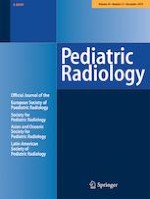Published in:

01-12-2019 | Subdural Hematoma | Original Article
Subdural hemorrhage rebleeding in abused children: frequency, associations and clinical presentation
Authors:
Jason N. Wright, Timothy J. Feyma, Gisele E. Ishak, Sergey Abeshaus, James B. Metz, Emily C. B. Brown, Seth D. Friedman, Samuel R. Browd, Kenneth W. Feldman
Published in:
Pediatric Radiology
|
Issue 13/2019
Login to get access
Abstract
Background
Limited documentation exists about how frequently radiologically visible rebleeding occurs with abusive subdural hemorrhages (SDH). Likewise, little is known about rebleeding predispositions and associated symptoms.
Objective
To describe the frequency of subdural rebleeding after abusive head trauma (AHT), its predispositions and clinical presentation.
Materials and methods
We evaluated children with SDHs from AHT who were reimaged within a year of their initial hospitalization, retrospectively reviewing clinical details and imaging. We used the available CT and MR images. We then performed simple descriptive and comparative statistics.
Results
Fifty-four of 85 reimaged children (63.5%) with AHT-SDH rebled. No child had new trauma, radiologic evidence of new parenchymal injury or acute neurologic symptoms from rebleeding. From the initial presentation, macrocephaly was associated with subsequent rebleeding. Greater subdural depth, macrocephaly, ventriculomegaly and brain atrophy at follow-up were associated with rebleeding. No other radiologic findings at initial presentation or follow-up predicted rebleeding risk, although pre-existing brain atrophy at initial admission and initial chronic SDHs barely missed significance. Impact injuries, retinal hemorrhages and clinical indices of initial injury severity were not associated with rebleeding. All rebleeding occurred within chronic SDHs; no new bridging vein rupture was identified. The mean time until rebleeding was recognized was 12 weeks; no child had rebleeding after 49 weeks.
Conclusion
Subdural rebleeding is common and occurs in children who have brain atrophy, ventriculomegaly, macrocephaly and deep SDHs at rebleed. It usually occurs in the early months post-injury. All children with rebleeds were neurologically asymptomatic and lacked histories or clinical or radiologic findings of new trauma. Bleeds did not occur outside of chronic SDHs. We estimate the maximum predicted frequency of non-traumatic SDH rebleeding accompanied by acute neurological symptoms in children with a prior abusive SDH is 3.5%.